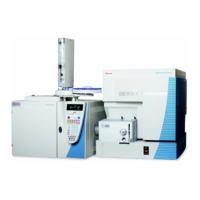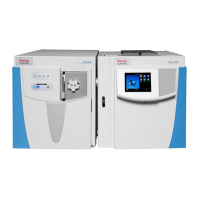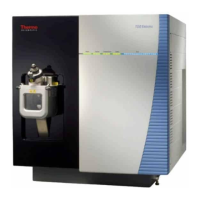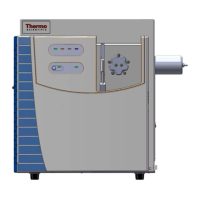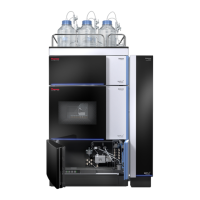4
Ion Transmission and Mass Analysis
Mass Analyzers
36 TSQ Endura and TSQ Quantiva Hardware Manual Thermo Scientific
Mass Analyzers
This section describes the components of the mass analyzer, voltages applied to the mass
analyzer electrodes, and mass analyzer operation during mass analysis. Ion manipulation and
mass analysis occur in a mass analyzer, which consists of three quadrupole rod assemblies (Q1,
Q2, and Q3) and two lens sets (EL21, EL22, EL23 and EL31, EL32, EL33). See Figure 17.
The following subtopics discuss the mass analyzer in detail:
• Quadrupole Rod Assemblies
• Applied RF and DC Fields
• Mass Analysis
• Collision Cell and CID Efficiency
• Quadrupole Offset Voltage
• Mass Analyzer Lenses
Quadrupole Rod Assemblies
The three rod assemblies in the mass analyzers are numbered from the API source end of the
manifold and are designated Q1, Q2, and Q3 (Figure 17). Quadrupoles Q1 and Q3 enable
high-resolution scans without signal loss.
For the TSQ Endura MS, quadrupoles Q1 and Q3 (also known as a hyperquads) are square
arrays of circular rods (Figure 22). For the TSQ Quantiva MS, quadrupoles Q1 and Q3 are
square arrays of precision-machined and precision-aligned, true hyperbolic rods (Figure 23).
Quartz spacers act as electrical insulators between adjacent rods.
Figure 22. Quadrupole Q1 or Q3 (TSQ Endura MS)
Figure 23. Hyperquad Q1 or Q3 (TSQ Quantiva MS)
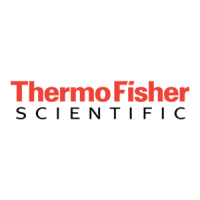
